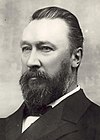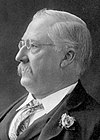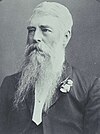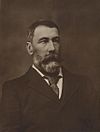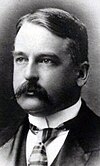Barton Government
The Barton government was the first government of the Commonwealth of Australia formed on January 1, 1901 . She served from January 1, 1901 to September 24, 1903.
Usually the leader of the largest party in the House of Representatives is charged with forming a government. Since the first elections to the Australian Parliament will not take place until 29./30. March, the governor-general- designate Earl of Hopetown , who arrived in Sydney on December 15, 1900, commissioned the Prime Minister of the most populous state of New South Wales , William Lyne , with the formation of a government. Lynne, who was an opponent of the Federation , the unification of the Australian colonies, encountered opposition from the leading federalists who refused to join a government under his leadership. Thereupon the Federalist Edmund Barton became tasked with forming a government on December 24th and presented his cabinet the following day.
All ministers belonged to the Protectionist Party , which advocated protective tariffs to protect domestic industry. In the general election , the Protectionist Party was the strongest party in the House of Representatives with 31 out of 75 seats , but was dependent on the support of the Labor Party .
Barton resigned on September 23, 1903 to serve as a judge in the High Court of Australia . He was succeeded as Prime Minister by Attorney General Deakin .
List of ministers
| Office | minister | Term of office | image |
|---|---|---|---|
| Prime Minister and Foreign Minister | Edmund Barton | January 1, 1901 - September 24, 1903 | |
| Attorney General | Alfred Deakin | January 1, 1901 - September 24, 1903 | |
| Interior minister | William Lyne | January 1, 1901 - August 11, 1903 | |
| John Forrest | August 11, 1903 - September 24, 1903 | ||
| Treasury minister | George Turner | January 1, 1901 - September 24, 1903 | |
| Minister for Trade and Customs | Charles Kingston | January 1, 1901 - July 24, 1903 | |
| William Lyne | August 11, 1903 - September 24, 1903 | ||
| Defense Minister | James Robert Dickson | January 1, 1901 - January 10, 1901 | |
| John Forrest | January 17, 1901 - August 10, 1903 | ||
| James Drake | August 10, 1903 - September 24, 1903 | ||
| Postmaster General | John Forrest | January 1, 1901 - January 17, 1901 | |
| James Drake | February 5, 1901 - August 10, 1903 | ||
| Philip Fysh | August 10, 1903 - September 24, 1903 | ||
| Vice President of the Executive Council | Richard O'Connor | January 1, 1901 - September 24, 1903 | |
| Minister without a portfolio | Elliott Lewis | January 1, 1901 - April 23, 1901 | |
| Philip Fysh | April 26, 1901 - August 10, 1903 |
Changes
- Defense Secretary James Robert Dickson died on January 10, 1901. He was succeeded by the previous Postmaster General John Forrest, who was replaced by Richard Drake, who was newly entering the cabinet.
- Elliott Lewis, Prime Minister of Tasmania and a minister with no portfolio, did not run for parliament and left the government on April 23. Im followed Philip Fysh.
- The Minister for Trade and Customs, Charles Kingston, resigned on July 24, 1903. The cause was a bitter dispute in the cabinet over the introduction of a conciliation and arbitration bill and the application of the law to English and foreign seafarers who were active in the coastal trade. Defense Secretary Forrest, supported by Prime Minister Barton, stood on the other side. This resulted in a redistribution of cabinet posts: Interior Minister Lynne succeeded Kingston, Defense Minister Forrest moved to the Interior Resort, the previous Postmaster General Drake took over the Ministry of Defense and Fysh, previously without a portfolio, became Postmaster General.
Web links
- Parliamentary Handbook for the 45th Parliament. (PDF; 13.4 MB) Part 6: Historical information on the Australian Parliament - Ministries and Cabinets. Parliament of Australia, p. 519 , accessed April 7, 2019 .
Individual evidence
- ↑ Chris Cunneen: Hopetoun, seventh Earl of (1860-1908) . In: Douglas Pike (Ed.): Australian Dictionary of Biography . Volume 9. Melbourne University Press, Carlton (Victoria) 1983, ISBN 0-522-84273-9 (English).
- ^ Martha Rutledge: Barton, Sir Edmund (Toby) (1849-1920) . In: Douglas Pike (Ed.): Australian Dictionary of Biography . Volume 7. Melbourne University Press, Carlton (Victoria) 1979, ISBN 0-522-84108-2 (English).
- ^ R. Norris: Deakin, Alfred (1856-1919) . In: Douglas Pike (Ed.): Australian Dictionary of Biography . Volume 8. Melbourne University Press, Carlton (Victoria) 1981, ISBN 0-522-84219-4 (English).
- ^ DD Cuthbert: Dickson, Sir James Robert (1832-1901) . In: Douglas Pike (Ed.): Australian Dictionary of Biography . Volume 8. Melbourne University Press, Carlton (Victoria) 1981, ISBN 0-522-84219-4 (English).
- ↑ Scott Bennett: Lewis, Sir Neil Elliott (1858-1935) . In: Douglas Pike (Ed.): Australian Dictionary of Biography . Volume 10. Melbourne University Press, Carlton (Victoria) 1986, ISBN 0-522-84327-1 (English).
- ^ John Playford: Kingston, Charles Cameron (1850-1908) . In: Douglas Pike (Ed.): Australian Dictionary of Biography . Volume 9. Melbourne University Press, Carlton (Victoria) 1983, ISBN 0-522-84273-9 (English).



